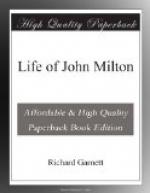It is a most interesting subject for inquiry from what sources, other than the Scriptures, Milton drew aid in the composition of “Paradise Lost.” The most striking counterpart is Calderon, to whom he owed as little as Calderon can have owed to him. “El Magico Prodigioso,” already cited as affording a remarkable parallel to “Comus,” though performed in 1637, was not printed until 1663, when “Paradise Lost” was already completed.[8] The two great religious poets have naturally conceived the Evil One much in the same manner, and Calderon’s Lucifer,
“Like the red outline of beginning Adam,”
might well have passed as the original draft of Milton’s Satan:—
“In
myself I am
A world of happiness and misery;
This I have lost, and that
I must lament
For ever. In my attributes
I stood
So high and so heroically
great,
In lineage so supreme, and
with a genius
Which penetrated with a glance
the world
Beneath my feet, that, won
by my high merit,
A King—whom I may
call the King of Kings,
Because all others tremble
in their pride
Before the terrors of his
countenance—
In his high palace, roofed
with brightest gems
Of living light—call
them the stars of heaven—
Named me his counsellor.
But the high praise
Stung me with pride and envy,
and I rose
In mighty competition, to
ascend
His seat, and place my foot
triumphantly
Upon his subject thrones.
Chastised, I know
The depth to which ambition
falls. For mad
Was the attempt; and yet more
mad were now
Repentance of the irrevocable
deed.
Therefore I chose this ruin
with the glory
Of not to be subdued, before
the shame
Of reconciling me with him
who reigns
By coward cession. Nor
was I alone,
Nor am I now, nor shall I
be, alone.
And there was hope, and there
may still be hope;
For many suffrages among his
vassals
Hailed me their lord and king,
and many still
Are mine, and many more perchance
shall be.”
A striking proof that resemblance does not necessarily imply plagiarism. Milton’s affinity to Calderon has been overlooked by his commentators; but four luminaries have been named from which he is alleged to have drawn, however sparingly, in his golden urn—Caedmon, the Adamus Exul of Grotius, the Adamo of the Italian dramatist Andreini, and the Lucifer of the Dutch poet Vondel. Caedmon, first printed in 1655, it is but barely possible that he should have known, and ere he could have known him the conception of “Paradise Lost” was firmly implanted in his mind. External evidence proves his acquaintance with Grotius, internal evidence his knowledge of Andreini: and small as are his direct obligations to the Italian drama, we can easily believe with Hayley that “his fancy caught fire from that spirited, though irregular and fantastic




